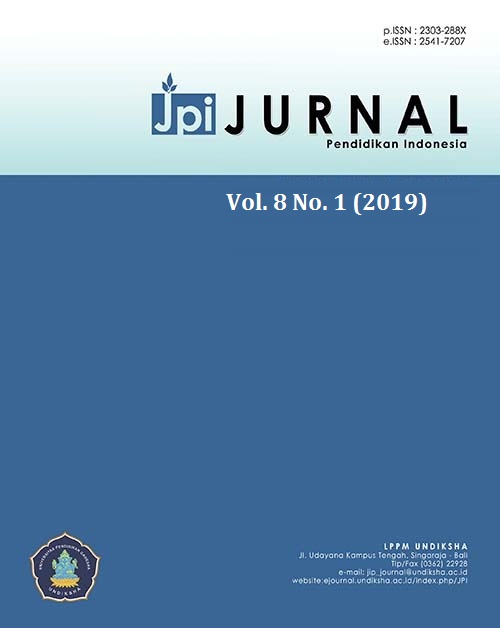Analysis of The Alignment Between Chemistry Content on TIMSS And Science-Chemistry Textbooks of Junior High School
DOI:
https://doi.org/10.23887/jpi-undiksha.v8i1.16101Keywords:
science-chemistry textbooks of Junior High School, subject content covered, Porter’s Alignment Index, TIMSS, cognitive demandsAbstract
This study is conducted to: (1) analyze the level of alignment between chemistry content on TIMSS with science-chemistry textbooks of Junior High School and (2) describe the discrepancies between chemistry content on TIMSS with science-chemistry textbooks of Junior High School in term of cognitive demands as well as subject content covered. This study was descriptive which used content analysis method. The content analysis was conducted on chemistry content of TIMSS and science-chemistry textbooks of Junior High School. To determine the degree of alignment criteria, this study used the method developed by Porter. Accordingly, the level of alignment is symbolized by Porter's Alignment Index. The results showed that the degree of alignment between TIMSS and and science-chemistry textbooks of Junior High School was 0.49 (low level of alignment). This imperfect alignment level is characterized by the discrepancies in term of subject content covered and cognitive demands among chemistry content on TIMSS and and science-chemistry textbooks of Junior High School. This can affect certainly toward the achievement of Indonesian students in TIMSS
References
Arikunto, S 200. Prosedur Penelitian Suatu Pendekatan Praktek.Jakarta: Rineka Cipta.
Arliani, E & Hidayati, K. 2013. ‘Model-model alignment antara penilaian dan kurikulum dalam pembelajaran matematika’, Prosiding Seminar Nasional Matematika dan Pendidikan Matematika universitas Negeri Yogyakarta, Yogyakarta, 9 November 2013.
Edwards, N. 2010. ‘An analysis of the alignment of the 12th physical science examination and the core curriculum in South Africa’. South Africa Journal of Education,vol 30, pp. 571-590.
Firman, H. 2013. ‘Alignment between national examination and national content standard of high school chemistry’. Disajikan pada Seminar Internasional Pendidikan Matematika, Sains dan Computer (MSCEIS), Bandung, 19 oktober 2013.
Fonthal, G. 2004. Alignment of state assessment and higher education expectations: definition and utilization of an alignment indeks. Laguna Hills. Los Angeles.
Gunilla, N. &Henrikson, W. 2008. ‘Alignment of standards and assessment: a theoretical and empirical study of methods for alignment’, Electronic Journal of Research in Educational Psychology, vol.6, no.3, pp.667-690.
Kementrian Pendidikan dan Kebudayaan. 2011. Survey Internasional TIMSS. Diakses 30 Januari 2018, [ http://litbang.kemdikbud.go.id/index.php/survei-internasional-timss].
Kesidou, S. & Roseman, J. E. 2002. How well do the middle school science programs measure up? Finding from Project 2061’s curriculum review, Journal of Research In Science Teaching, vol.39, 522-549.
Liu, E & Lu, Q. 2012. Alignment between high school biology content standart and the standardized test of four province in China, Journal of Biological Education, vol. 46, no.3, pp.149-164.
Mullis, I. V. S., Martin, M. O., Ruddock, G.J., O’sullivan, C. Y. & Preuschoff. C. 2011undik. TIMSS 2011 assesment framework. Diakses januari 2018, [http://timss.bc.edu/timss2011/downloads/TIMSS2011_Frameworks.pdf].
Porter, A.C., Smithson, J.L. 2001. ‘Are content standards being implemented in the classroom? : a methodology and some tentative answers’, Dalam From The Capitol The classroom: Standards-Based Reform in the States, S. H. Fuhrman (ed) Chicago National Society for The Study of Education. [online]. Tersedia: http://jsmithson.wceruw.org.
Porter, A. C. 2002, ‘Measuring the content of instruction: Uses in research and practice’ Educational Research, vol.31,no.7, pp 3-14.
Smithson, J. 2009. Alignment content analysis of TIMSS and PISA mathematics and science assesments using the surveys of enacted curriculum methodology, University of Wisconsin. Madison.
Winkel, W. S. 2005. Psikologi pendidikan dan evaluasi belajar. Jakarta: Gramedia.
Downloads
Published
Issue
Section
License
Authors who publish with the Jurnal Pendidikan Indnesia agree to the following terms:
- Authors retain copyright and grant the journal the right of first publication with the work simultaneously licensed under a Creative Commons Attribution License (CC BY-SA 4.0) that allows others to share the work with an acknowledgment of the work's authorship and initial publication in this journal.
- Authors are able to enter into separate, additional contractual arrangements for the non-exclusive distribution of the journal's published version of the work (e.g., post it to an institutional repository or publish it in a book), with an acknowledgment of its initial publication in this journal.
- Authors are permitted and encouraged to post their work online (e.g., in institutional repositories or on their website) prior to and during the submission process, as it can lead to productive exchanges, as well as earlier and greater citation of published work. (See The Effect of Open Access)








